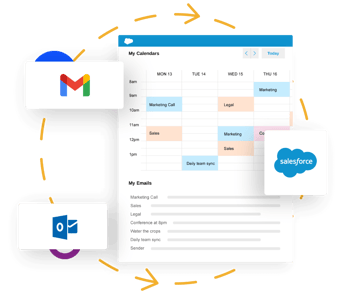- Solutions
-
Products
-
Resources
Sales Automation: What It Is, How It Works, and What to Automate First by Kristi Campbell View all Blog Posts >Get the App, Get the Sidebar, & Get Your Trial Going HereUnleash limitless growth opportunities by partnering with Cirrus Insight.
- Pricing
Filter By:
- All topics
- Sales Intelligence
- Salesforce
- Sales Productivity
- Sales Strategy
- Sales Prospecting
- Book More Meetings
- Sales Activity Data
- Company News
- Sales Leadership
- Sales Metrics
- Team Scheduling
- Prospect Smarter
- AI
- Serious Insights
- Comparison
- Conversation Intelligence
- Sync To Your CRM
- Email Blast
- Email Campaigns
20 Winning Sales Deck Examples for 2025 That Close Deals
The goal of a sales deck is to "visually and textually present your sales narrative to your ideal customer in a way that convinces them to buy your solution." - Peter Kazanjy
Just like we did with our giant list of sales email templates, we've collected 20 sales deck examples to help you create your own winning deck.
Table of Contents
- What is a sales deck?
- Examples of winning sales decks
- Sales deck best practices
- How to create a sales deck that closes deals
What is a Sales Deck?
A sales deck is a visual presentation—typically in slide format—used by sales teams to communicate the value of a product or service during a pitch. It’s more than just a set of slides; a great sales deck tells a compelling story that speaks directly to the prospect’s pain points, offers a solution, and builds a case for why your offering is the right choice.
Whether you're presenting live in a meeting or sharing it as a follow-up, the goal of a sales deck is to build trust, spark interest, and drive the deal forward. The best sales decks are clear, engaging, and customized to the audience.
20 Real-World Sales Deck Examples That Work
Zenefits Sales Deck
This sales deck from Zenefits is simple yet informative. It can be modified for any industry as the design elements in this template are basic but it has consistency in its style, typography, and colors.
Zuora Sales Deck
To make a clear distinction between its brand and its competitors, Zoura’s deck uses image-rich backgrounds and contains minimal texts. Zoura's sales deck contains a presentation that communicates its value, vision, and story.
Facebook for Business Sales Deck
Facebook’s sales deck is persuasive because it appeals to multiple audiences by providing different strategies based on business objectives.
Uber for Business Sales Deck
In crafting its sales pitch, Uber has a remarkable concept that is catchy and somehow connected to what's happening worldwide. It depicts the growth model of Uber, the digital revolution, and the system that solves the taxi industry's current problems.
Reddit Ad Sales Deck
Reddit stepped up and built a sales deck that was engaging. It contains custom memes and images that make you laugh. But in advertising and marketing, it demonstrates that it can be a solid contender standing alongside advertising giants like Google and Facebook.
Immediately Sales Deck
A sophisticated and professional-looking deck from Immediately. It illustrates a concise and clear message. It also displays mobile-based sales solutions for companies.
Grindr Sales Deck
Grindr is an LGBTQ social networking and online dating app. It has an innovative, sharp, and modern style theme, including mini infographics and short text as well which is readable and organized.
Snapchat Ad Sales Deck 2015
Similar to its 2014 counterpart, Snapchat’s 2015 sales deck gets right to the point. It doesn’t waste space with boring or fluffy intros, and instead kicks things off strong with “Snapchat is the best way to reach 13-34-year-olds”.
Snapchat Ad Sales Deck 2014
Snapchat’s 2014 sales deck does a great job at getting right to the point about its key differentiator and core product functionality. This sets the tone for the rest of the presentation which is built around these core features.
Tumblr Ad Sales Deck
This deck from Tumblr does a good job of visually showing their new business product, and not just letting the text do all of the selling. On that note, we would have liked to see more concise and easy to remember sentences.
ProdPad Sales Deck
ProdPad’s sales deck was easy to grasp. It directly addresses the problem of its target market with simple visualizations of its solutions using large, bold fonts and fun photos.
LeadCrunch Sales Deck
This sales deck concentrated on the launch of LeadCrunch’s new product. With larger fonts - numbers are emphasized and icons are used for visual appeal. The presentation is seamless through a clear color scheme.
Adgibbon Sales Deck
Adgibbon’s superb business presentation visually illustrates its product and keeps each slide lively and engaging.
Bounce Exchange Sales Deck
Bounce Exchange’s deck tackles all of its potential customers' specific needs by highlighting their product features that summarize its data visualization, analysis, and design.
Appsflyer Sales Deck
This customer-centric sales deck has a simple and minimalistic style yet compelling, on point, and graphically interesting. It explains more of its product’s capabilities and its customers’ needs.
Splunk Sales Deck
This deck clearly explains the product's advantages and gives a step-by-step walkthrough of how the product performs. It explains succinctly what data it operates on and how it is implemented.
Office365 Sales Deck
With a vivid color scheme and graphics, Office 365's business presentation is top-notch. It also concisely conveys the message and highlights its features and the data was easily interpreted using pictograms.
Contently Sales Deck
Founders Sales Deck
Peter Kazanjy, founder of TalentBin (acquired by Monster) put together a must watch presentation called Sales Decks for Founders. Even if you're not a founder, it's equally as relevant for marketers and salespeople who want to create a winning deck:
Founders for Sales Presentation Video
The Example TalentBin Sales Deck
Sales Deck Best Practices
A great sales deck doesn’t just inform—it persuades. To make your pitch memorable and effective, keep these best practices in mind:
1. Lead with a Clear Problem
Start by identifying a challenge your audience cares about. Hook their attention by showing you understand their pain points before jumping into your solution.
2. Tell a Story
Structure your deck like a narrative. Introduce the problem, present your solution, show the results, and finish with a clear call to action. People remember stories more than stats.
3. Focus on Outcomes, Not Features
Don’t just list product features. Emphasize business value—how your solution saves time, increases revenue, reduces risk, or improves efficiency.
4. Keep It Simple and Visual
Use clean, consistent slides. Limit each slide to one main idea and support it with visuals or short bullet points. Avoid text-heavy slides.
5. Include Social Proof
Add credibility with case studies, testimonials, or logos of existing clients. Show how others have succeeded with your solution.
6. Tailor It to Your Audience
Customize your deck based on who you’re talking to—different personas care about different outcomes. A CFO may want ROI, while a VP of Sales wants quota achievement.
7. End with a Strong CTA
Always close with a clear next step: book a demo, start a trial, or schedule a follow-up call. Guide the prospect forward in their journey.
How to Create a Winning Sales Deck
Your sales deck templates should support your presentation. It provides a starting point and context to have a conversation around, not a crux to coast through a generic pitch.
Opt for graphs, charts, images, and white space over text. The more words on the page, the more they're reading the text and not listening to what you're saying.
The meeting is for your prospect, not you. If they'd like to steer the conversation in a new direction then let them do so. Be flexible and adapt to where the interests of your prospects lie.
The less they talk the less chance you have of closing the sale. Even though you're presenting this is still a two-way dialogue, so get them involved in the conversation where you can.
Tailor your presentation based on your prospect's interests. It should feel like it's customized to them. Don't have an overly broad focus - use what you've learned about your prospect and what they care about.
At a minimum, your Sales Deck should include:
- Who you are: keep it brief and relevant
- The "before" or problem section: make them feel the pain
- The "after" or solution section: show them how good life can be
- Why you're the best solution: connect the dots between before, after, and your solution
- Who else you're working with: validate your solution with social-proof
- A call-to-action: bring the conversation to a head (e.g. with pricing, they're going to ask)
- Appendices: objection, "choose your own adventure", and edge-case slides
Frequently Asked Questions (FAQs)
How do I make a sales deck?
In creating your own sales deck, follow the traditional sales narrative: identify the audience and their dilemma, encourage them to understand the problem, present your offer as the most realistic alternative, and provide a case study to show that it works.
What should be included in a sales deck?
There should be a few key elements of a sales deck: a catchy opening slide (cover image); a story to start your sales pitch. Data is also necessary such as graphs, statistics, charts, quotes, and which are also supported by other facts and information to be presented to the target audience.
What’s the difference between a sales deck and a pitch deck?
While the terms are often used interchangeably, a sales deck is usually tailored for direct customer conversations, focusing on product value and solving a specific problem. A pitch deck, often used by startups, is typically aimed at investors and emphasizes the business model, market opportunity, and growth potential.
How long should a sales deck be?
Keep it concise—10 to 15 slides is ideal. Each slide should support your narrative and move the conversation forward without overwhelming your audience with details.
Can I use the same sales deck for every prospect?
You can start with a template, but customization is key. Tailor your deck to the prospect’s industry, pain points, and decision-making role for the highest impact.
Should I send the deck before or after the meeting?
If the deck is self-explanatory, it can be shared ahead of time to spark interest. However, it's usually more effective to walk prospects through it during a meeting, then follow up with a copy afterward.
What tools can I use to create a sales deck?
Popular tools include PowerPoint, Google Slides, Canva, and Pitch. Choose one that fits your workflow and allows for easy design, collaboration, and sharing.
Make your CRM the Single Source of Truth
Eliminate busy work for your team and increase pipeline conversions while mitigating risk.


.png?width=1268&height=1772&name=Sidebar-C%20(1).png)


